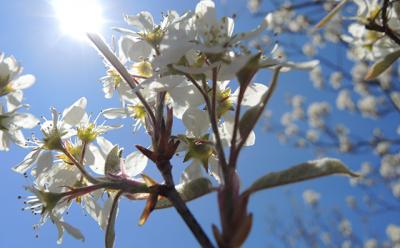Nature Notes: Now Shad, Next Dogwood

Spring is moving right along in good stead. A car ride through the local roads gives one an up-to-date reading of its progress. Today, for example, during a back-and-forth, up-and-down trip through the back roads of Northwest Woods, the signs of advancing spring were readily apparent.
The shoulders have greened up. The black and scarlet oaks are beginning to flower, while the white oaks, which burst out a good week or two later, are looking on jealously. Shads and sweet cherries, which began to blossom two weeks ago, are holding on, but it’s hard to see the white cherry blowers because the leaves are almost fully expanded and hiding them. By the time the shad leaves are full out, the petals will have fallen and the very first stages of fruiting will have begun.
After the shads and the cherries come the dogwoods. They don’t have true petals, but the largest bracts assume that role, turning a lustrous white from pink at their peak. Apparently, the bees and other insect pollinators do not have degrees in botany or arborculture; they treat the dogwood blooms like any other flower.
Unlike the sweet cherries, the wild cherries, which outnumber the former 10 to 1, leaf out long before the flowers appear. The leaves on the ones in my yard are nearly fully expanded, while in Northwest Woods, the wild cherry leaves are only halfway out. You will notice that several of them on the edges of Route 114 between the villages of Sag Harbor and East Hampton are almost naked. If you take a closer look, you will see cobwebby clusters where branch meets trunk — the tent caterpillars have been out and about devouring the leaves as quickly as they unfurl. Tent caterpillars use their tents to protect them from predators during the daylight hours. They stick to members of the genus Prunus, particularly wild black cherries and beach plums of the woods and dunes, respectively.
Dandelions have been here more than 100 years and they’ve been flowering since before the middle of April. There were several patches evident on the shoulders of the 20 or so roads I traveled. A few patches had both fresh yellow flowers and ripe globular whitish seed heads ready to scatter at any moment. One could spend a lifetime trying to eradicate them and never quite accomplish the job.
The red, or swamp, maples are found throughout the Northwest Woods. They are among the first large trees to flower; most have already dropped their red blooms and are working on expanding their foliage. In wetter spots — and there are many such areas in Northwest — they are often accompanied by tupelos (also called black gums, sour gums, etc.), which are completely bare now. They are the last of our native trees to get their leaves and, ironically, the first to redden and drop them to the ground come September.
I stopped along Alewife Brook Road, which ends at the waters of Northwest Harbor, and took a walk into Scoy Pond. No alewives at all in the stream. The new culvert pipe under the road is hardly adequate to allow them to pass from Ely Brook Pond to the stream, but there were a great many sprouting oak seedlings from last year’s huge crop of chestnut oak acorns. Chestnut oak acorns mature in their first year — not like the acorns of our other local oaks, which take two years before they drop — and the acorn nut is bright pink-red. Along the trail you can see them here and there. Try to pick one up and you meet resistance; a well-established root is already holding them in place.
Coming back I took Bull Path through the heart of Long Island’s only native white pine forest. Because it wasn’t paved until the late 1980s, it has only a few utility poles at its south end that spring from Stephen Hand’s Path. Thus, as you drive north the oaks, pitch pines, and white pines are not at all pruned, but quite stately and tall, street trees growing as they should grow, free from the encumbrances of electric and telephone wires. You get the idea that the dominant white pines will retain their dominance well into the future, as all of the smaller trees, down to those one foot in size, are white pines and very thickly distributed.
You can pick out a sassafras or hickory here and there. They are just beginning to bud out, sparsely so along the trunks and branches. And, yes, the white oaks are still completely bare. When they start to flower in another week or so, the branches will look sanguine, as white oak leaves and flowers mostly start out red.
As I approached Sag Harbor along Route 114 there were many green areas along the pavement. They were made up of fresh green Norway and planetree maple flowers. What was the signal that made them all drop to the ground at the same time? Most certainly it was the combination of their respective genomes and increased daylight.
God and evolution don’t leave things up to chance. I had to ask myself, if I were in Norway at this very moment would I see similar green patches along the pavement?
Finally, I’m on Long Beach Road, Noyac Bay is quiet, the invasive yellow spurge is resplendent, and the beach plums are beginning to bloom. A fitting end to a fitting trip as I motor home.
Larry Penny can be reached via email at [email protected].
